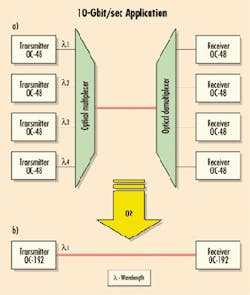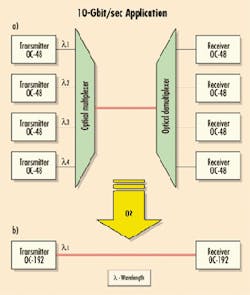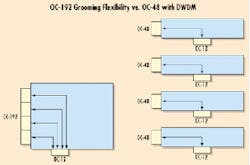The rush to move from OC-48 to OC-192
As long-haul and local carriers deploy 10-Gbit/sec transmission equipment, the need for more capacity still requires a Synchronous Optical Network.
Stanton Zeff, P.E.
Fujitsu Network Communications Inc.
With bandwidth re quirements increasing exponentially, the move from OC-48 (2.5 Gbits/sec) to OC-192 (10-Gbit/sec) transport is accelerating. Whether the fiber serves a long-haul route, a competitive local-exchange carrier (CLEC), or an incumbent's metro loop, it's no longer a question of whether the network will be upgraded to OC-192-rather, it's a question of when.
Long-haul operators are moving to OC-192 because of its capacity. Carriers such as MCI WorldCom and Level 3 Communications are investing heavily in 10-Gbit/sec systems. At the same time, OC-192, which began as an interexchange carriers' product, is making inroads in the local-exchange market. Although LECs' bandwidth requirements in metro areas may be slower to evolve, US West (acquired by Qwest Communications International), SBC, and Bell Atlantic are beginning to actively deploy OC-192. The effort to upgrade central-office interconnects from 2.5 Gbits/sec to 10 Gbits/sec is also gaining momentum.
Despite ongoing development, none of the technology available today can compete with the flexibility of a Synchronous Optical Network (SONET)-based OC-192 system. For that reason, it is safe to predict that a steep ramp-up of OC-192 will continue for the next two to three years in conjunction with dense wavelength-division multiplexing (DWDM) platforms.Figure 1. A 10-Gbit/sec configuration requires the use of 16 OC-48 terminations (a) versus only four terminations with OC-192 (b).
The move to OC-192 often depends on how soon the network's traffic will justify the cost of the capacity increase and whether any technical issues will keep a carrier from moving forward. Interexchange carrier ALLTEL (Little Rock, AR) is installing OC-192 equipment to reinforce existing OC-48 rings-after more wholesale business dramatically increased traffic in some areas. OC-192 offers a cost-effective method to maximize use of space and provides the necessary capacities that reduce the need for other near-term upgrades, observes Andy Alexander, ALLTEL's staff manager of transport.
Most telecommunications traffic hubs back to main offices. The pure density of OC-192, even if only used to hub other rings coming into a switching office, makes for a compelling argument against lower-rate systems. It allows a quadrupling of bandwidth over the same fiber, with little technical risk.
While the use of DWDM in OC-48 systems remains practical and well accepted, there are cost and capacity issues involved. DWDM is an equipment-intensive solution, with additional devices at each end of a span. Even though OC-48 is a mature and relatively inexpensive technology, it is not able to meet the growing bandwidth demands of data-centric networks.
The economic justification for OC-192 is no mystery to long-haul operators. Most operators do not upgrade technology just to save money; carriers typically reach a point where the amount of traffic requires a higher-capacity solution. Given the necessity of expanding the network, the objective becomes cost minimization.
The old rule of thumb that a network requirement for two to two-and-a-half OC-48 equivalents justifies installation of a single OC-192 still holds, but the analysis only begins there. With the cost of an OC-192 network node about twice that of an OC-48 node, achieving the equivalent bandwidth with an OC-48 DWDM system on a 2-fiber bidirectional line-switched ring (BLSR) is more than twice the cost of an OC-192 system. This configuration also requires the use of 16 OC-48 terminations versus only four terminations with OC-192 (see Figure 1).
With OC-192, there are the added benefits of purchasing and maintaining fewer network elements, requiring less floor space, having a generally lower power requirement, and a more modest impact on the overall fiber plant. For new builds, it is important to keep in mind that an OC-192 network offers increased reliability and requires less equipment with lower overall life cycle costs.Figure 2. Unlike a network that uses OC-48 with dense wavelength-division multiplexing to achieve 10-Gbit/sec transmission, an infrastructure with OC-192 can save the carrier money and space because the system has the ability to groom traffic internally.
An OC-192 system can handle the equivalent of 129,000 simultaneous phone calls over a single fiber pair. It should have as large a crossconnect matrix as possible to support hundreds of STS channels into and out of the same node, allowing a carrier to drop at least 20 Gbits/sec of capacity. Other features important in an OC-192 system include nonblocking connectivity to high-speed OC-192 ports, hairpinning among the lower-rate optical tributaries, the ability to groom signals internal to the system for substantial cost and space savings (see Figure 2), and full interconnect support up to a 4-fiber BLSR architecture.
Today, service providers invest in data networks that are reliable and can meet service-level agreement requirements. OC-48 supports aggregation of 64-kbit/sec "plain old telephone service" (POTS) lines and can drop electrical DS-3s (44.736 Mbits/sec). Today's market, however, demands an OC-192 system, which can drop optical OC-3/3c (155 Mbits/sec), OC-12/12c (622 Mbits/sec), and even OC-48/48c.
Plenty of service providers expect to meet the demand for higher-speed access with digital-subscriber-line (DSL) services. But at some point, these lines must be multiplexed into a bigger pipe. Today's DSL access multiplexers (DSLAMs) have OC-3 and OC-12 interfaces. The number of DSLAMs in a carrier's network typically is several thousand; in the face of that, a cluster of OC-12s, or even OC-48s, can come up short. Clearly, in larger metro areas, OC-192 will prove the superior solution to fiber exhaustion.
Carriers hit by the initial wave of demand for bandwidth are bracing for an even bigger one. The demand for bandwidth is driven by applications ranging from the Internet to enterprise interconnections. Due to the total cost of ownership of a fiber network, carriers are more willing to move forward with OC-192, even if such a move cannot be fully cost-justified today. The scope of a major project, with a three-year build-out timeframe, shows the wisdom of such a strategy.
Because of the initial installation cost of deploying fiber, carriers should plan for far more capacity than is required in the near term. While carriers must absorb the expense of the larger fiber installation upfront, the cost of trenching, labor, and making connections is incremental compared to adding fiber in the future. The unused fiber stays dark until needed.
Fiber exhaust is a problem that many incumbents increasingly face. According to the MultiMedia Telecommunications Association's (MMTA's) 2000 Market Review and Forecast, AT&T has about 50% of its fiber-miles lit, while Sprint has 85% lit.
In contrast, newer competitors like Qwest, Williams, and Frontier (acquired by Global Crossing) have less than 10% of their fiber lit. A similar pattern is noted among LECs, with Bell Atlantic and GTE using about half of their deployed fiber.
The MMTA report also notes the popularity of OC-192 in CLEC networks. Qwest is multiplexing eight OC-192 streams onto a single fiber, allowing one million calls to be carried on each fiber route.
A few years ago, there was talk of a "battle" between DWDM and OC-192. The reality is that carriers are using OC-192 and DWDM. Time and technology have bypassed the argument over multiplexing OC-48s.
A more realistic concern might be DWDM systems that are not "tuned" to OC-192 but are still optimized for OC-48. If a DWDM system can handle only OC-48, three-fourths of the bandwidth capability is lost. There is a huge difference between 80 wavelengths of OC-48 and 80 of OC-192. The long-term goal is to achieve more than 160 channels of 10 Gbits/sec for a total capacity of more than 1.6 Tbits/sec.
Chromatic dispersion (CD) and polarization-mode dispersion (PMD) also got a lot of press a few years ago when only a couple of suppliers offered OC-192 systems. Some claimed the dispersion problem would kill 10-Gbit/sec deployment.
Today, the industry knows better. In simple terms, dispersion represents the degree of distortion that takes place as a signal travels through a transmission medium. CD is caused by different wavelengths of light traveling at different speeds. Since the wavelengths arrive at different times, the transmitted pulse may spread as it travels. PMD is the movement of the lightwave in a direction perpendicular to the main direction of the beam. Both dispersion forms can be dealt with, and there are varying "comfort levels" with each. It may add cost to overcome CD or PMD, but neither characteristic is a show stopper. Like potholes on the expressway, engineers know that CD and PMD are there and should be avoided as much as possible.
Fixed dispersion-compensation modules can handle CD. The way to deal with PMD is to measure it and make a go/no-go decision. Either the line is fine, or it is not. In 95% to 98% of the fiber routes in this country, PMD is not a problem.
With OC-192, a service provider realizes STS-1 (52-Mbit/sec) granularity with most vendors' products. Today's time-division multiplexed systems offer the best bet for granularity, although that may change as technology evolves.
It is impractical today to put lower-rate electrical drops on an OC-192 system. Thus, there are no DS-1s (1.544 Mbits/sec) or DS-3s dropped directly off an OC-192. With the trend toward optical hubbing, the required OC-3s or OC-12s provide this granularity. There are 192 STS-1 channels, so the most straightforward solution is to sacrifice a tiny bit of granularity for the huge advantage of optical interconnection. At some point, it becomes a question of how fine to split a hair (or fiber). Although electrical drops will be around for quite some time, the new approach is the optical interconnect.
The bottom line always comes down to creating the bandwidth required to meet the explosive capacity demand. OC-768 (40 Gbits/sec) is on the horizon, and with it, similar questions about the embedded base of lower-capacity technology will arise. Five years from now, carriers may want to run Asynchronous Transfer Mode (ATM) and Internet protocol (IP) over wavelength networks without SONET as an underlying architecture. At that point, DWDM may become the solution of choice.
A long-term plan should consider what happens when traffic demands that carriers quadruple the existing OC-192, and the underlying OC-48s are unable to handle the pressure. The answer is to start implementing OC-192 today to avoid network bottlenecks tomorrow.
Stanton Zeff is a registered professional engineer and the product marketing manager of high-speed SONET products at Fujitsu Network Communications Inc. (Richardson TX). He can be reached at [email protected].


